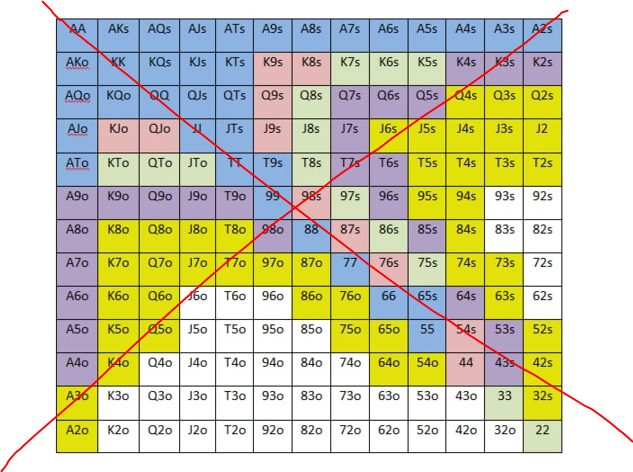We can not go around preflop play and hand selection when talking about solid poker skills. You'll need to know by heart this part of the game. You'll not only need a solid preflop strategy but to stick to it. However, you can still deviate from it if you have good reasons. What it means is that you need to know for each situation your base ranges and the reasons why they are constructed in the way they are. In this first part, we'll go through the reasoning.

You might find dozens of preflop range sheets online, which can differ vastly (often without context). Why is that, and how to decide which one to choose? I suggest selecting none of them; instead, work out your own ranges. However, it can be challenging and time-consuming, not to mention that it can lead to errors. The issue with online charts is that they were constructed considering different variables. If you want to spend less time working out your ranges or are afraid of committing errors, you can use/subscribe to a poker solver. The great thing about solvers is that you can define these variables and develop proper calculations based on them. However, this process also might be time-consuming and requires basic knowledge of the programs, besides the fact that your computer might also need to match high technical requirements. Still, you'll get an educated answer on what ranges you should use.
The best way is to look up online solvers such as GTO Wizard or GTOx. They are user-friendly, and their visuals facilitate the understanding of ranges. With one click, you can compare different rake structures and strategies (for instance, mixing cold calling or only 3betting, etc.)
The key factor is the rake structure in your poker room and the actual rake on your limit. On micro and small stakes, the rake can exceed 10bb/100, while on high stakes, it might be just a fraction of a bb/100. Beginners often overlook this fact, but it's crucial to understand the massive impact rake has on the preflop strategy. Simply put, some hands are just not profitable to play anymore on small stakes, or the thresholds are somewhat different.
Another element you need to consider is the amount you'd like to bet/raise (or face as the defender). It also has a considerable impact on the ranges you should play. That's why I said earlier to don't use any preflop charts found online. Because they are very much dependent on factors that likely don't match your situation, in a nutshell, the bigger you bet, the tighter your range should be. The other way around, the smaller you bet/raise, the wider range is allowed to use.
2. Raise first in and limping

Still, let's see some baselines where you can start working on your preflop play. You've probably never thought about it this way, but our only goal is winning the blinds. That's what generates the action, and our hand and position are dependent on the profitability to do so. Without blind bets, we'd like to only play with aces, and no other hand is incentivized to put money voluntarily into the pot. The blinds and the circumstances create the possibility of working out preflop opening ranges.
So the first rule is to always get in the action by betting/raising and avoid limping and cold calling. The only exception is the BTN and the BB positions. The BTN is because you will play in position, and the latter is because you are pretty much incentivized to cold call with a wide range. The reason why not to limp is simple. Every hand where a flop is dealt gets raked. Your winrate will be significantly hurt if you pay an "extra" rake that you could avoid. The other reason is that a mixed preflop strategy is way harder to execute and play well. So you add another branch of the possible decision tree from the first step. The best you can do is to simplify your game at all times when it's possible without losing EV.
Okay, but I've seen Linus sometimes limping from the small blind and other positions. As I mentioned, high-stakes games have very different rake structures (sometimes even with added antes or straddles), which change the correct strategies. You won't get into a situation like this on micro and small stakes. Small blind limping could add to your strategic repertoire, but the rake is so high that under NL1000, it just doesn't worth the fuss. Besides that, do you remember what I said earlier about keeping things simple?
Take away
As always in poker, be open thinking about preflop ranges as a dependent-on-the-circumstances phenomenon. Remember, your goal is to steal the blinds. So avoid limping and paying rake as much as possible. In the following article, we'll go into some details about how your opening ranges should look like, preflop opening sizes, and when to deviate from your base strategy.
Go ahead and steal the blinds ;)
Good luck at the tables














0 comments